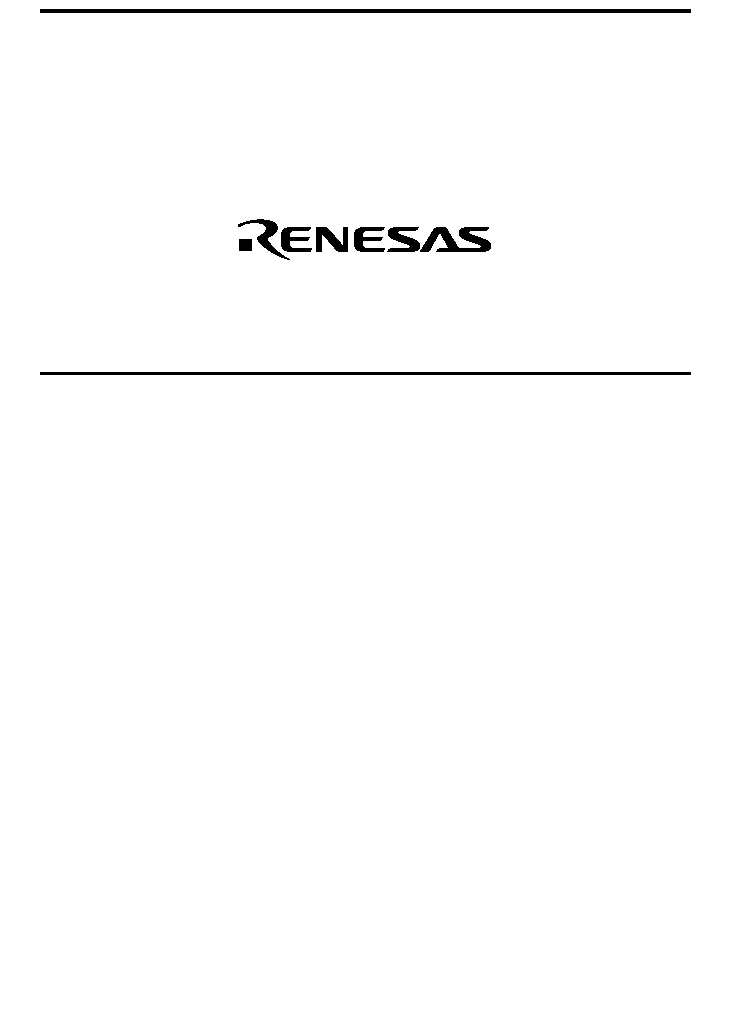Document Outline
- Description
- Features
- Block Diagram
- Interface
- Registers
- MultiMediaCard Communication
- SPI Communication
- Error Handling
- Power Supply
- Characteristics
- Electrical Characteristics
- References
- Number Representations
- Abbreviations and Terms
- Physical Outline

Regarding the change of names mentioned in the document, such as Hitachi
Electric and Hitachi XX, to Renesas Technology Corp.
The semiconductor operations of Mitsubishi Electric and Hitachi were transferred to Renesas
Technology Corporation on April 1st 2003. These operations include microcomputer, logic, analog
and discrete devices, and memory chips other than DRAMs (flash memory, SRAMs etc.)
Accordingly, although Hitachi, Hitachi, Ltd., Hitachi Semiconductors, and other Hitachi brand
names are mentioned in the document, these names have in fact all been changed to Renesas
Technology Corp. Thank you for your understanding. Except for our corporate trademark, logo and
corporate statement, no changes whatsoever have been made to the contents of the document, and
these changes do not constitute any alteration to the contents of the document itself.
Renesas Technology Home Page: http://www.renesas.com
Renesas Technology Corp.
Customer Support Dept.
April 1, 2003
To all our customers

Cautions
Keep safety first in your circuit designs!
1. Renesas Technology Corporation puts the maximum effort into making semiconductor products better
and more reliable, but there is always the possibility that trouble may occur with them. Trouble with
semiconductors may lead to personal injury, fire or property damage.
Remember to give due consideration to safety when making your circuit designs, with appropriate
measures such as (i) placement of substitutive, auxiliary circuits, (ii) use of nonflammable material or
(iii) prevention against any malfunction or mishap.
Notes regarding these materials
1. These materials are intended as a reference to assist our customers in the selection of the Renesas
Technology Corporation product best suited to the customer's application; they do not convey any
license under any intellectual property rights, or any other rights, belonging to Renesas Technology
Corporation or a third party.
2. Renesas Technology Corporation assumes no responsibility for any damage, or infringement of any
third-party's rights, originating in the use of any product data, diagrams, charts, programs, algorithms, or
circuit application examples contained in these materials.
3. All information contained in these materials, including product data, diagrams, charts, programs and
algorithms represents information on products at the time of publication of these materials, and are
subject to change by Renesas Technology Corporation without notice due to product improvements or
other reasons. It is therefore recommended that customers contact Renesas Technology Corporation
or an authorized Renesas Technology Corporation product distributor for the latest product information
before purchasing a product listed herein.
The information described here may contain technical inaccuracies or typographical errors.
Renesas Technology Corporation assumes no responsibility for any damage, liability, or other loss
rising from these inaccuracies or errors.
Please also pay attention to information published by Renesas Technology Corporation by various
means, including the Renesas Technology Corporation Semiconductor home page
(http://www.renesas.com).
4. When using any or all of the information contained in these materials, including product data, diagrams,
charts, programs, and algorithms, please be sure to evaluate all information as a total system before
making a final decision on the applicability of the information and products. Renesas Technology
Corporation assumes no responsibility for any damage, liability or other loss resulting from the
information contained herein.
5. Renesas Technology Corporation semiconductors are not designed or manufactured for use in a device
or system that is used under circumstances in which human life is potentially at stake. Please contact
Renesas Technology Corporation or an authorized Renesas Technology Corporation product distributor
when considering the use of a product contained herein for any specific purposes, such as apparatus or
systems for transportation, vehicular, medical, aerospace, nuclear, or undersea repeater use.
6. The prior written approval of Renesas Technology Corporation is necessary to reprint or reproduce in
whole or in part these materials.
7. If these products or technologies are subject to the Japanese export control restrictions, they must be
exported under a license from the Japanese government and cannot be imported into a country other
than the approved destination.
Any diversion or reexport contrary to the export control laws and regulations of Japan and/or the
country of destination is prohibited.
8. Please contact Renesas Technology Corporation for further details on these materials or the products
contained therein.

Preliminary: The specifications of this device are subject to change without notice. Please contact your
nearest Hitachi's Sales Dept. regarding specifications.
HB28H016RM2/HB28D032RM2
HB28B064RM2
Reduced Size MultiMediaCard
16 MByte/32 MByte/64 MByte
ADE-203-1380A (Z)
Preliminary
Rev. 0.1
Dec. 27, 2002
Description
These Hitachi Reduced Size MultiMediaCard(RS-MMC
TM
)s, HB28H016RM2, HB28D032RM2, and
HB28B064RM2 have same functions as MultiMediaCard
s, half size mostly, highly integrated flash
memories with serial and random access capability. These are accessible via a dedicated serial interface
optimized for fast and reliable data transmission. This interface allows several cards to be stacked by
through-connecting their peripheral contacts. These Hitachi Reduced Size MultiMediaCards are fully
compatible to a new consumer standard, called the MultiMediaCard system standard defined in the
MultiMediaCard system specification [1]. The MultiMediaCard system is a new mass-storage system
based on innovations in semiconductor technology. It has been developed to provide an inexpensive,
mechanically robust storage medium in card form for multimedia consumer applications. MultiMediaCard
system enables the designs of inexpensive players and drives, without moving parts. A low power
consumption and a wide supply voltage range favor mobile, battery-powered applications such as audio
players, organizers, palmtops, electronic books, encyclopedias and dictionaries. Using very effective data
compression schemes such as MPEG, the MultiMediaCard systems will deliver enough capacity for all
kinds of multimedia data: software/programs, text, music, speech, images, video and so on.
Note: MultiMediaCard
is a trademark of Infineon Technologies AG,
and is licensed to MMCA (MultiMediaCard Association).
The Electrical specifications of Reduced Size MultiMediaCard(RS-MMC
TM
)s and standard
MultiMediaCard
s are the same. Therefore, the explanations after page3 are based on the
standard MultiMediaCard
s.

HB28H016/D032/B064RM2
Rev.0.1, Dec. 2002, page 2 of 88
Features
� 16 MByte/32 MByte/64 MByte memory capacity
� On card error correction
� MultiMediaCard system standard compatibility
System specification version 3.1 compliant
System specification version 3.3 compliant (Physical Outline)
SPI mode supports the single and multiple block read and write operations
Block and partial block read supported (Command classes 2)
Stream read supported (Command class 1)
Block write and erase supported (Command classes 4 and 5)
Group write protection (Command classes 6)
Stream write supported (Command classes 3)
Password data access protection
Small erase block size of 512 bytes, tagged erase supported
Read block size programmable between 1 and 2048 bytes
V
CC
= 2.7 V to 3.6 V operation voltage range (V
CC
= 2.0 V to 3.6 V for the interface)
No external programming voltage required
Damage free powered card insertion and removal (No operation)
4kV ESD protection (Contact pads)
� High speed serial interface with random access
Up to 10 stacked card (at 20 MHz, V
CC
= 2.7 to 3.6V)
Access time: 300 �s (typ) (at 20 MHz, V
CC
= 2.7 to 3.6V)
� Low power dissipation
High speed: 216 mW (max) (at 20 MHz, V
CC
= 3.6 V): HB28H016/D032/B064RM2

HB28H016/D032/B064RM2
Rev.0.1, Dec. 2002, page 3 of 88
Block Diagram
1
2
3
4
V
PP
Generator
5
6
7
Internal clock
Interface
CID[127:0]
OCR[31:0]
Flash control
Core control
CSD[127:0]
RCA[15:0]
CMD
P
o
w
e
r on reset unit
Register
set
DA
T
V
CC
CS CMD/DI
DAT/DO
CLK/SCLK
Interface driver
Memory core
All units in these Hitachi MultiMediaCards are clocked by an internal clock generator. The Interface
driver unit synchronizes the DAT and CMD signals from external CLK to the internal used clock signal.
The card is controlled by the three line MultiMediaCard interface containing the signals: CMD, CLK,
DAT (refer to the chapter "Interfaces"). For the identification of the MultiMediaCard in a stack of
MultiMediaCards, a card identification register (CID) and a relative card address register (RCA) is
foreseen. An additional register contains different types of operation parameters. This register is called
card specific data register (CSD). The communication using the MultiMediaCard lines to access either the
memory field or the registers is defined by the MultiMediaCard standard (refer to the chapter
"Communication"). The card has its own power on detection unit. No additional master reset signal is
required to setup the card after power on. It is protected against short circuit during insertion and removal
while the MultiMediaCard system is powered up (refer to the chapter "Power Supply"). No external
programming voltage supply is required. The programming voltage is generated on card.
These Hitachi MultiMediaCards support a second interface operation mode the SPI interface mode. The
SPI mode is activated if the CS signal is asserted (negative) during the reception of the reset command
(CMD0) (refer to the chapter "SPI Communication").




